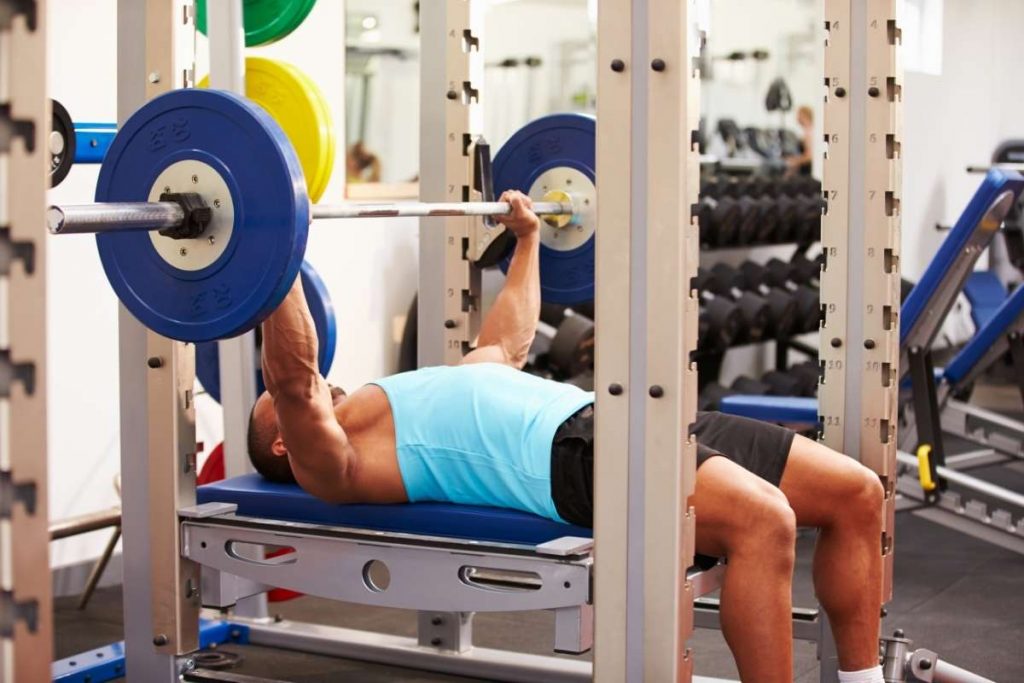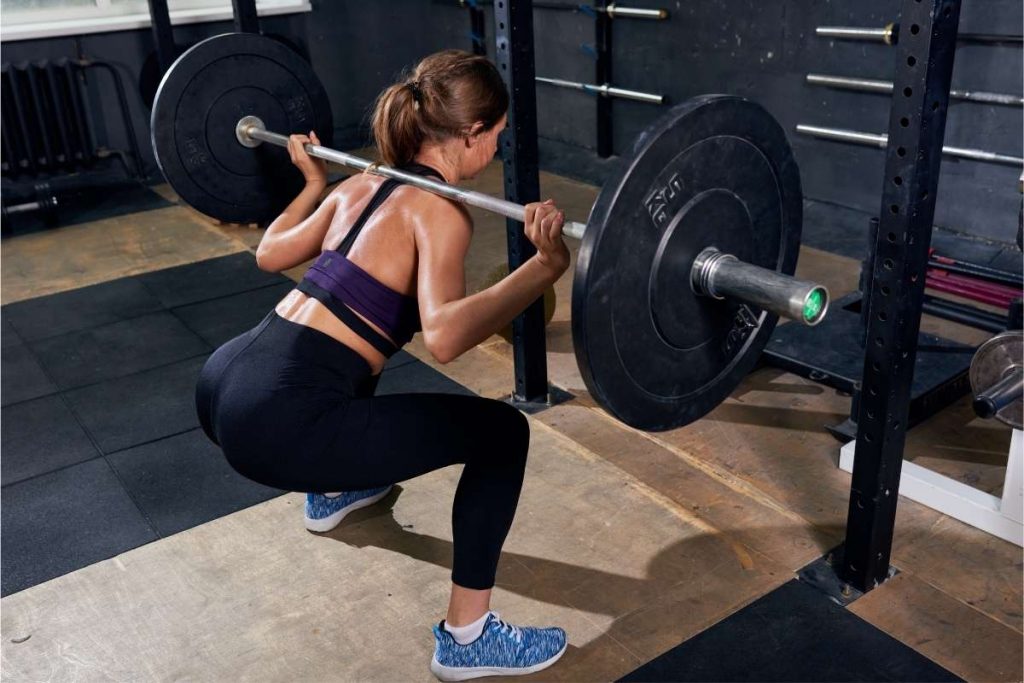What's inside
When people think of a 4-day workout split, most would picture the upper-lower body split.
While this is a great routine for beginners looking to transition from something like a 3-day full-body routine, there’s another lesser-known variation.
The push-pull split is an effective way to train to cover all the major muscle groups. It’s an ideal option for those that only have four days per week to train.
This article is a comprehensive breakdown of the phases, exercises, and training methods used in the 4-day push-pull workout routine.
It also includes an example 4-day push-pull workout program for you to try if you think this split will benefit your gym results.
We’ll start by distinguishing the 4-day push-pull program from its contemporaries.
What exactly is a push-pull workout split?
Related: 10 Best Vertical Pull Exercises

A push-pull workout split divides the major muscle groups of the body into two separate groups.
Rather than splitting the body between the upper body and lower body, certain muscles are grouped based on their joint movements.
The following is a brief synopsis of what each workout looks like:
Push Day
- Trains movements such as horizontal and vertical pressing and squatting
- Joint motions include shoulder flexion, abduction, horizontal adduction, elbow extension, hip and knee extension, and ankle plantar flexion
Pull Day
- Trains movements of horizontal and vertical pulling, hip hinging, and knee bending
- Joint actions include shoulder extension, elbow flexion, back extension, hip extension, knee flexion
As you can see, this type of session includes both upper and lower body muscles but isn’t quite a full-body workout.
The 4-day push-pull also usually includes two separate push and pull workouts for a total of four unique sessions.
The workout in this article follows this model. You might find it makes it more interesting since it includes more exercises.
Push and Pull Muscle Groups
Related: 16 Best Low Impact Cardio Machine

The muscle groups in this split are put together based on functional, compound movements.
For example, in an upper-body move like a push-up or bench press, the chest, shoulders, triceps, and core are working together.
The same goes for pulling exercises like pull-ups or rows, with the upper and lower back, shoulders, and biceps working to pull the upper limbs back.
In the lower body, there are also pushing and pulling movements.
The squat uses the entire lower body but mainly recruits the quadriceps to extend the knees to standing.
For a lower limb pulling movement, the glutes and hamstrings are often used to pull objects off the ground by extending the hips.
The hamstrings also pull the heel toward the thigh through flexion at the knee joint.
What are the main push muscle groups?
- Pectoralis major
- Anterior and middle deltoids
- Triceps brachii
- Quadriceps
- Calves
- Core muscles
What are the main pull muscle groups?
- Trapezius
- Latissimus dorsi
- Biceps brachii
- Posterior deltoid
- Spinal erectors
- Glutes
- Hamstrings
- Forearms
- Core muscles
Is a push-pull workout routine effective?
Related: 10 Best Exercises To Include In Your Push Day Workout Program
alt/image: push-pull workout routineA push-pull workout routine can be used as an effective tool for meeting many different fitness goals.

A push-pull workout routine can be used as an effective tool for meeting many different fitness goals.
This program has a good balance of frequency and volume. The intensity can be altered to compliment strength, muscle-building, or endurance goals.
As mentioned, this type of split workout is a great step from beginner to intermediate level. It can get a lifter through to the high intermediate to an advanced stage.
While advanced lifters with years of experience tend to use 5-6 days per week programs like the bro split, or PPL.
That being said, there are many benefits to using the 4-day push-pull routine.
What are the benefits of a 4-day push-pull workout routine?

Increased Training Frequency
One benefit of training with a 4-day push-pull split is that every muscle group gets two sessions per week.
This sits in line with the ACSM recommendations that each muscle be trained two to three times per week to increase muscle size.
It also aligns with recommendations for overall training frequency, sitting right in the sweet spot between three and five sessions per week.
This gives the program an advantage over the bro split, at least in this regard.
The bro split can have excessive (up to six days per week) overall frequency, with only one session for each muscle group.
No Leg Day!
For those who hate training legs – and are maybe guilty of skipping leg day – the 4-day push-pull is a good solution.
This program allows you to hit all the lower muscle groups, just tied in with the ‘fun’ stuff.
It also sprinkles in a couple of leg exercises each session, so the lower body work doesn’t become too fatiguing or overwhelming.
Plus, it helps with the next point…
Good Pump Every Session
Part of the reason many people love weightlifting is the feeling you get from pumping blood into the muscles.
This is especially true for the ‘mirror muscles,’ like the chest, shoulders, and arms.
The 4-day push-pull routine allows you to work your legs for a balanced physique while also leaving the gym every session with a good pump.
You get the enjoyment of training upper body, with the benefit of not looking too ‘top heavy’ (a nice way of saying chicken legs).
So, the 4-day push-pull split sounds amazing at this point. But are there any downsides to this workout plan compared to others?
What are the possible drawbacks to a 4-day push-pull workout routine?

Workout Times
Just like its big brother, the upper-lower body training split, the push-pull split requires a decent amount of time to complete a session.
In each session, there’s a combination of large compound exercises, as well as isolation movements for several upper and lower body muscles.
Coupled with the proper warm-up, inter-set rest periods, and post-workout recovery, sessions can easily take an hour or more.
This isn’t including any additional cardio you may want to do on top of resistance training.
In the program below, we’ve included a bonus streamlined version of the 4-day push-pull program.
This keeps in the essential, bang-for-your-buck compound lifts and moves that will ensure good strength and size gains.
It cuts out some of the accessory movements and extra volume for smaller muscle groups in the interest of making the workout times significantly shorter.
Recovery
Another challenge with the push-pull routine is to ensure you are recovering adequately.
Although you are targeting different muscle groups each session, there will always be some crossover in the joint tissues, as well as the nervous system.
This is known as central fatigue, as opposed to peripheral fatigue in the muscles themselves.
For example, in an upper-lower split, although you train the same number of times per week, your upper body joints get to recover on lower body days, and vice versa.
With the push-pull split, however, the shoulders, knees, hips etc. will be getting four workout days a week as opposed to two.
While there’s nothing inherently wrong with this approach, it just requires extra care and attention when it comes to your recovery methods.
Frequency
While the above point is concerned with training too much, another possible downside for some may be a lack of overall training volume.
As mentioned, many advanced trainees like to train five or six days per week.
While a split like the upper-lower body split could be performed three times a week for a total of six sessions, the push-pull split isn’t ideal for this scenario.
This is because, as mentioned in the last point, this could lead to overtraining in the joints, excessive fatigue, and decreased performance.
That being said, if you do aim to train four days per week and have the off days for recovery or conditioning work, this program will be perfect for you.
Next, let’s take a look at some of the fundamental exercises that will be included in any good push-pull workout routine.
The Most Common Exercises That May Be Included in Your Push-Pull Workout Routine
1. Barbell Bench Press
The bench press is the ultimate push exercise and should be the first entry into any push-pull workout routine.
The barbell bench press engages a high level of muscle activation in all of the push muscles, including the pecs, delts, and triceps.
It’s also one of the best exercises to focus on increasing your maximal strength.
How-To Perform Barbell Bench Press:
- Lay on a flat bench
- Unrack the barbell from the supports
- Inhale and lower the bar to mid-chest level
- Forcefully exhale and use the chest to lift bar until the arms are straight
- Perform desired number of repetitions
- Safely re-rack the bar before disengaging body
Benefits: Good balance of stability and freedom of movement, best push exercise for strength progression
Pro Tips: Push the soles of the feet into the floor, squeeze your butt, and pull the belly button in for a strong lifting position.
2. Barbell Squat
The squat is essentially the lower body version of the bench press.
This whole-body exercise is best done with the barbell for the highest level of overall muscle activity.
While taking some practice to master the technique, this movement is also super-functional. It’ll make you better at everything from dunking a basketball to getting off the toilet.
How-To Perform Barbell Squat:
- Set the bar at the appropriate height and load weight + safety clips
- Step under bar and rest it across back of shoulders with a comfortable grip
- Unrack the weight by standing tall and stepping back
- Inhale and sit the hips back to lower down into the squat
- Lower until upper leg is parallel to the floor
- Exhale and lift back to starting position
- Once reps are completed, step forward to rack weight
Benefits: Highly functional movement, very high overall muscle recruitment, stimulates hormone response
Pro Tips: Push the heels down, keep the eyes forward, and maintain a natural arch in the back throughout the movement.
3. Pull-Ups
Next, we have the pull-up, a calisthenics exercise that covers all the bases when it comes to upper body pulling.
Pull-ups target muscles such as the lats, traps, biceps, and forearms, as well as requiring a lot of stability from other muscles.
While difficult to get into initially, pull-ups are an exercise worth mastering. Adding weight with a vest or belt can keep you progressing with this exercise long-term.
How-To Perform Pull-Ups:
- Grab bar at chosen grip width and position
- Hang from bar with the arms straight
- Pull the shoulder blades back and down
- Lead with the chest as you pull the elbows down and back
- Pull the collarbone toward the bar
- Hold at the top position and contract the muscles
- Slowly control down to an engaged hang position
- Repeat for repetitions and carefully drop from bar
Benefits: Functional open-chain kinetic exercise, excellent core-strengthener, gateway exercise to advanced calisthenics skills
Pro Tips: Keep the entire body as stiff as possible to avoid wasting energy on this lift.
4. Deadlift
Another must-include for any good pull workout, the deadlift is king for its ability to work the entire posterior chain.
From the traps to the hamstrings, deadlifts activate everything on your back side.
Variations such as the straight-leg deadlift or Romanian deadlift focus more on the glutes and hamstrings, with the conventional or trap-bar deads working the quads and lower back more.
How-To Perform Deadlift:
- Stand in front of loaded barbell
- Hold the bar outside the legs with straight arms
- Bend the knees and sit back with the hips
- Push through the heels, breathe out and stand up straight
- Drive the hips into the bar at the top of the movement
- Slowly return to starting position with a straight back
- Perform all reps
Benefits: Develops entire posterior chain, builds grip strength
Pro Tips: There are many variations of the deadlift, such as the straight-leg, Romanian, or Sumo. Experiment with what gives you the best results.
5. Military Press
Finally, the military press is a functional and athletic movement that should be added wherever possible to a push session.
Overhead pressing is important not only for athletics but for lifelong shoulder strength and function.
This move can be more challenging than the bench press, as it’s done in a standing position without the support of the bench.
However, this just makes the movement even better at recruiting more muscle groups to stabilize the body.
How-To Perform Military Press:
- Stand behind center of barbell
- Grab the bar at shoulder width or slightly wider position
- Raise the bar to the collarbone
- Breathe out and push the bar up, clearing your head from the bar’s path
- Inhale and slowly lower bar back to starting position
- Repeat desired reps and lower bar back to the floor
Benefits: High level of deltoid muscle fiber recruitment, athletic movement
Pro Tips: The legs, glutes, and core are critical for strength and to protect the spine, so keep them activated at all times.
6. Accessory/Isolation Movements
In addition to the compound, multi-joint exercises above, a push-pull split program will also include many isolation exercises for the different muscle groups.
These single-joint exercises serve multiple purposes and round out the program.
They’re good for strengthening lagging muscle groups, preventing large muscles from ‘overtaking’ smaller muscles, and strengthening muscles that help prevent injury.
Classic examples include things like the bicep curl, triceps extensions, hamstring curls, and shoulder external rotations.
Many of these movements are included in the program below, so without further ado, here it is!
The Best 4-Day Push-Pull Workout Program
Related: Muscle Gain Workout Plan With PDF

The following push-pull workout schedule contains two distinct push workouts and two pull workouts.
The sessions contain the fundamental compound lifts as well as accessory exercises to cover all your bases.
This program is aimed at increasing your strength in the big lifts while stimulating muscle growth for each muscle group.
The workouts are done in two-day increments, with at least one rest day between one round of push-pull and the next.
Ease into the program, and take additional rest if you feel fatigued – either during the session or between workouts.
Monday – Push Workout 1
Warm-Up: Five minutes of 10 arm circles forward and back, 10 upper body twists each way, 10 leg swings forward/back and side/side, 1-2 warm-up sets for bench press and squats.
| Exercise | Sets x Reps | Rest |
| Bench press | 4-5×6-8 | 2-3 min |
| Barbell squat | 4-5×6-8 | 2-3 min |
| Cable crossover | 3-4×10-12 | 1 min |
| Standing calf raise | 3-4×12-15 | 1 min |
| Lateral raise | 3×12-15 | 1 min |
| Cable tricep pushdown | 3×10-12 | 1 min |
Estimated Workout Duration: 50min-1hr 15min, including warm-up.
Tuesday – Pull Workout 1
Warm-Up: 10 arm circles forward and back, 10 upper body twists each way, 10 leg swings forward/back and side/side, 1-2 warm-up sets of hanging scapular engagement.
| Exercise | Sets x Reps | Rest |
| Pull-up/chin-up | 3-4xMAX -1 | 3 min |
| Barbell hip thrust | 3-4×8-10 | 1-2 min |
| Barbell shrug | 3×8-10 | 1 min |
| Hamstring curl machine | 3×10-12 | 1 min |
| Cable straight arm pushdown | 3×8-10 | 1 min |
| Barbell / EZ bar curl | 3-4×6-8 | 1-2 min |
Estimated Workout Duration: 40-60 mins, including warm-up.
Wednesday
Rest/30 min. moderate cardio
Thursday – Push Workout 2
Warm-Up: General warm-up including 10 arm circles forward and back, 10 upper body twists each way, 10 leg swings forward/back and side/side, 1-2 warm-up sets for military press and leg extension.
| Exercise | Sets x Reps | Rest |
| Military press | 4-5×6-8 | 2-3 min |
| Leg extension | 3-4×12-15 | 1 min |
| Dumbbell incline press | 3-4×8-10 | 1-2 min |
| Seated calf raise | 3×12-15 | 1 min |
| Reverse fly machine | 3×10-12 | 1 min |
| Lying tricep extension | 3-4×8-10 | 1 min |
Estimated Workout Duration: 50min-1hr 15min, including warm-up.
Friday – Pull Workout 2
Warm-Up: Five-minute warm-up with 10 arm circles forward and back, 10 upper body twists each way, 10 leg swings forward/back and side/side, 1-2 warm-up sets for deadlift.
| Exercise | Sets x Reps | Rest |
| Deadlift | 4-5×6-8 | 3 min |
| Lat pulldown | 3×8-10 | 1-2 min |
| Single leg RDL | 3×10-12 each side | 30 sec |
| One arm row | 3×8-10 each side | 1 min |
| dB lat pullover | 3×10-12 | 1 min |
| Incline dB curl | 3-4×10-12 | 1 min |
Estimated Workout Duration: 60 min-1hr 20 min, including warm-up.
Saturday
Rest/30 min. moderate cardio
Sunday
Rest/30 min. moderate cardio
Bonus: Streamlined 4-Day Push-Pull Workout Routine
As mentioned, the sessions in the program above can be quite long. If you have the time, that program is recommended for best results.
For those with more limited time, the following shortened program is for you.
It still contains the same workout days but focuses on the compound lifts and a little accessory work.
These sessions should take only 30-40 minutes with a full warm-up and cool-down, and are also good for beginners transitioning into intermediate training.
You can always start with this program and gradually progress to the full version over several weeks or months.
Push Workout 1
| Exercise | Sets x Reps | Rest |
| Bench press | 4-5×6-8 | 2-3 min |
| Barbell squat | 4-5×6-8 | 2-3 min |
| Standing calf raise | 3-4×12-15 | 1 min |
Pull Workout 1
| Exercise | Sets x Reps | Rest |
| Pull-up/chin-up | 3-4xMAX -1 | 3 min |
| Barbell hip thrust | 3-4×8-10 | 1-2 min |
| Barbell/EZ bar curl | 3-4×6-8 | 1-2 min |
Push Workout 2
| Exercise | Sets x Reps | Rest |
| Military press | 4-5×6-8 | 2-3 min |
| Leg extension | 3-4×12-15 | 1 min |
| Dumbbell incline press | 3-4×8-10 | 1-2 min |
Pull Workout 2
| Exercise | Sets x Reps | Rest |
| Deadlift | 4-5×6-8 | 3 min |
| Lat pulldown | 3×8-10 | 2 min |
| One-arm row | 3×8-10 each side | 1 min |
Pro Tips for a Successful 4-Day Push-Pull Workout Routine

Advancing Progress
Like any workout program, the 4-day push-pull routine will only get you results if you consistently work harder each session, each week, and each month.
If you simply perform the same workouts over and over without progressing, your results will eventually plateau.
While taking care of your recovery, make sure you are always pushing for slightly more than you did last time.
This won’t be the case for every single exercise of every single session. Some days you will be more tired than others.
The important thing is that the general trend should be moving forward toward your goals, whether they be for strength, size, or performance in sport or work.
Progressive Overload Fundamentals
Knowing that you should be advancing your performance while using the 4-day push-pull split is one thing, but what exactly should you focus on?
The most common ways to progressively overload your training include increasing the intensity, volume, or frequency.
Since we are trying to stick to a 4-day split (for now), frequency is relatively fixed.
This leaves increasing the weight you lift in a given exercise, or performing extra reps or sets.
Again, since the framework above already consists of quite long sessions, adding more sets may be counterproductive.
This means the best way to progress in this program is a combination of increasing load and reps.
You don’t need to add reps or weight for every exercise, every session. But don’t rest on your laurels, either.
Just as it’s okay to go easier on days when your energy is down, also take advantage of good days to try to push that extra rep, or try a heavier set.
Training Within Rep Ranges for Hypertrophy
Use the rep ranges in the example program as a guide. When you can complete all the recommended sets and repetitions with a certain weight, it’s time to move up.
The compound lifts like bench press and squats are purposely set at lower rep ranges to focus on increasing maximal strength.
The isolation movements have higher rep ranges to work in some metabolic fatigue and stimulate muscle hypertrophy.
Training to Fatigue
Related to the point above, this means pushing yourself to the point of muscular failure.
For many people, the mind gives up well before the body reaches what it’s capable of.
Especially in the big compound lifts, the discomfort can make trainees stop short of their potential.
While correct and safe technique is of course paramount, don’t use it as an excuse to skimp out on the reps that will stimulate the results you want.
The research on training to fatigue is a mix of those who think it is a prerequisite for hypertrophy, and those who posit that a rep or two short doesn’t compromise gains.
That being said, people aren’t generally very good at estimating what two reps short of failure is.
It’s easier to push and at least try that last rep, and to stop if the technique isn’t there.
A good tip is to definitely push to failure (and beyond) at the very least on your last set of each exercise.
Frequently Asked Questions
Can you do push-pull 4 days a week?
While a push-pull split is technically a two-day split (breaking the muscle groups of the whole body into two sessions), it can be done four days a week for two reasons.
First, as this article points out, having a higher training frequency of at least two sessions per week per muscle group leads to greater muscle growth.
In addition, 4-day push-pull splits like the ones in this article have two separate push and pull workouts, meaning that yes, four days a week is great for push-pull.
Is a 4-day push-pull-legs enough?
Depending on the level of training you’re at, a four-day split of resistance training can definitely be sufficient to develop strength and muscle size.
Especially if you are working around additional training such as sports-specific training or additional conditioning workouts, this four-day split is optimal.
The next step from a 4-day push-pull program would be to something like the PPL – push-pull-legs split, performed twice per week for six total training days.
This would increase the volume further for more growth stimulus but would require more careful recovery.
What is a good four-day-a-week workout routine?
While this article highlights the 4-day push-pull split, there are many ways to train four days per week.
This depends entirely on your goals and preferences, whether it be bodybuilding, weight loss, sports, or general health.
Other examples of training on a 4-day workout split include full-body four times per week, an upper-lower body split, or a 4-day bro split.
Experiment with what works best for you, or consult a fitness professional who can guide you.
What are the possible disadvantages of a 4-day push/pull workout routine?
While there are many benefits of the 4-day push-pull split, there are some potential downsides, as mentioned above.
To cover them again briefly, these include long workout times, balancing recovery, and for some, wanting more frequency.
This doesn’t mean that a 4-day push-pull program is ineffective or poses any unnecessary risk.
It simply means that no program is perfect for every person at every stage of their fitness journey.
Final Thoughts
So, what did you think about our 4-day push-pull workout routine?
We think it’s an underrated program and a good alternative to the upper-lower split for those who want to train four days per week.
Let us know if you use the 4-day push-pull – or another split routine – in the comments.
If you have a friend or family member who might like this kind of program, feel free to share this article with them as well.

